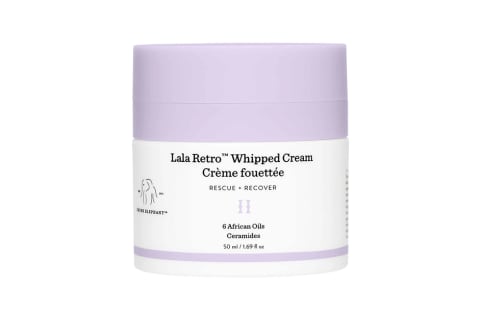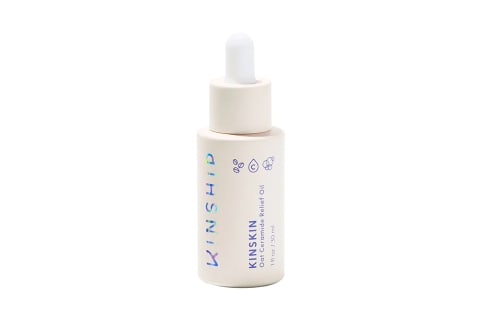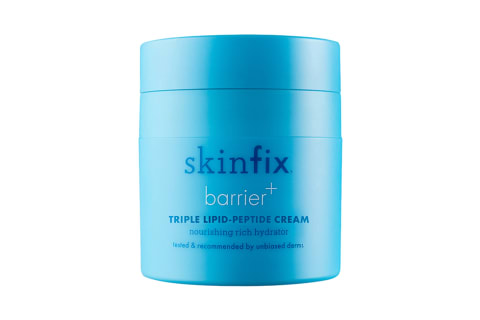Other products, however, are essential. Moisturizer ranks high on the list. No matter how dry or oily your skin is, you need to keep it hydrated. But before committing to a product, you may want to understand what’s in the formula first. The skin barrier, with the help of ceramides, “works as a guard to keep moisture inside the skin and environmental stressors like irritants, allergens, and microbes outside of the skin,” Koestline explains. “When applied topically, ceramides mimic the skin’s own moisturizing system,” she continues. This is why ceramides are often referred to as “skin-identical,” ingredients. What’s more, ceramides are, “Non-sensitizing to the skin and eyes,” Koestline says. This is why they’re top of the list for skin care formulas designed for hypersensitive skin types and skin conditions like eczema. “Plant oils like jojoba oil, safflower oil, and grapeseed oil are rich in natural ceramides,” Koestline says. Phytoceramides often come from oat and wheat as well. “Meanwhile, lab-derived synthetic ceramides are also available and are totally safe to use,” she continues. To sum up—like many skin care ingredients, synthetic ceramides are not something to look down upon. In some ceramide-rich formulas, you may even find both forms whipped up into an ultra-hydrating cocktail. This mechanism contributes to a stronger skin barrier that is more equipped to fend off external aggressors. For example, according to Koestline, Ceramide III and IV “Act as building blocks of the lipid barrier,” she says. In a slightly different way, Ceramide I holds together the lipid bilayer, Koestline notes. So keep an eye out for the word ceramide, followed by a number or a letter. Ceramide AP, Koestline says, is a substructure of ceramides, as are Ceramide EOP, Ceramide NG, and Ceramide NS—so add those to the list of possible names. Finally, “There are also precursors to ceramides that are used along with ceramides, like sphingosine, cholesterol, phytosphingosine that readers can see on INCI lists,” Koestline says. These will often be present in ceramide serums and creams—more on that in a bit. See hyaluronic acid is a humectant, which means it pulls water into the skin. For example, if you applied an HA serum to damp skin, the hyaluronic acid will help your skin absorb the water present and water in your following serums and moisturizers. This is why hyaluronic acid helps the skin look juicy and plump. But ceramides, as you now know, have quite a different job. They work as emollients, which means they help fill the cracks in the skin and encourage a smooth surface that holds on to moisture for longer. Both ingredients are A+ for any skin type and will work wonders for dry skin as well. Remember to use your hyaluronic acid serum first on damp skin and follow up with your ceramide cream—our top picks to follow. In fact, using ceramides in combination with potentially irritating ingredients can actually be extremely beneficial. Here’s how a few of your favorites pair with ceramides: “So using ceramide-containing skin care products is useful as part of a therapeutic approach to these skin conditions,” Zeichner says. There are plenty of ceramide creams out there, some formulated with heavy occlusives for eczema and ultra-dry skin, while others are acne-safe—a few top picks below. Keep an eye out for skin-identical ceramides that will directly contribute to the ceramide levels in your skin, whether it be from topical products or supplements and food. To support your natural levels of ceramide production, be sure to commit to a healthy skin care routine, eat a balanced diet packed with skin-loving foods (a few A+ additions here), and protect your skin barrier with moisturizer, SPF, and try your best to avoid over-exfoliation, retinoid reactions, and sunburns. You can also take beauty supplements that have phytocermaides in them. But, in the current skin care market, ceramide creams tend to include a more abundant concentration of ceramides as well as a more diverse blend—here’s a list of the 10 best clean and effective ceramide creams if you want to get shopping ASAP. A few foods that are rich in ceramides include:
Lala Retro™ Whipped Moisturizer with Ceramides
Plant Ceramide Rich Moisture Cream
Kinskin Ceramide Barrier Repair Oil
Barrier+ Triple Lipid-Peptide Face Cream






